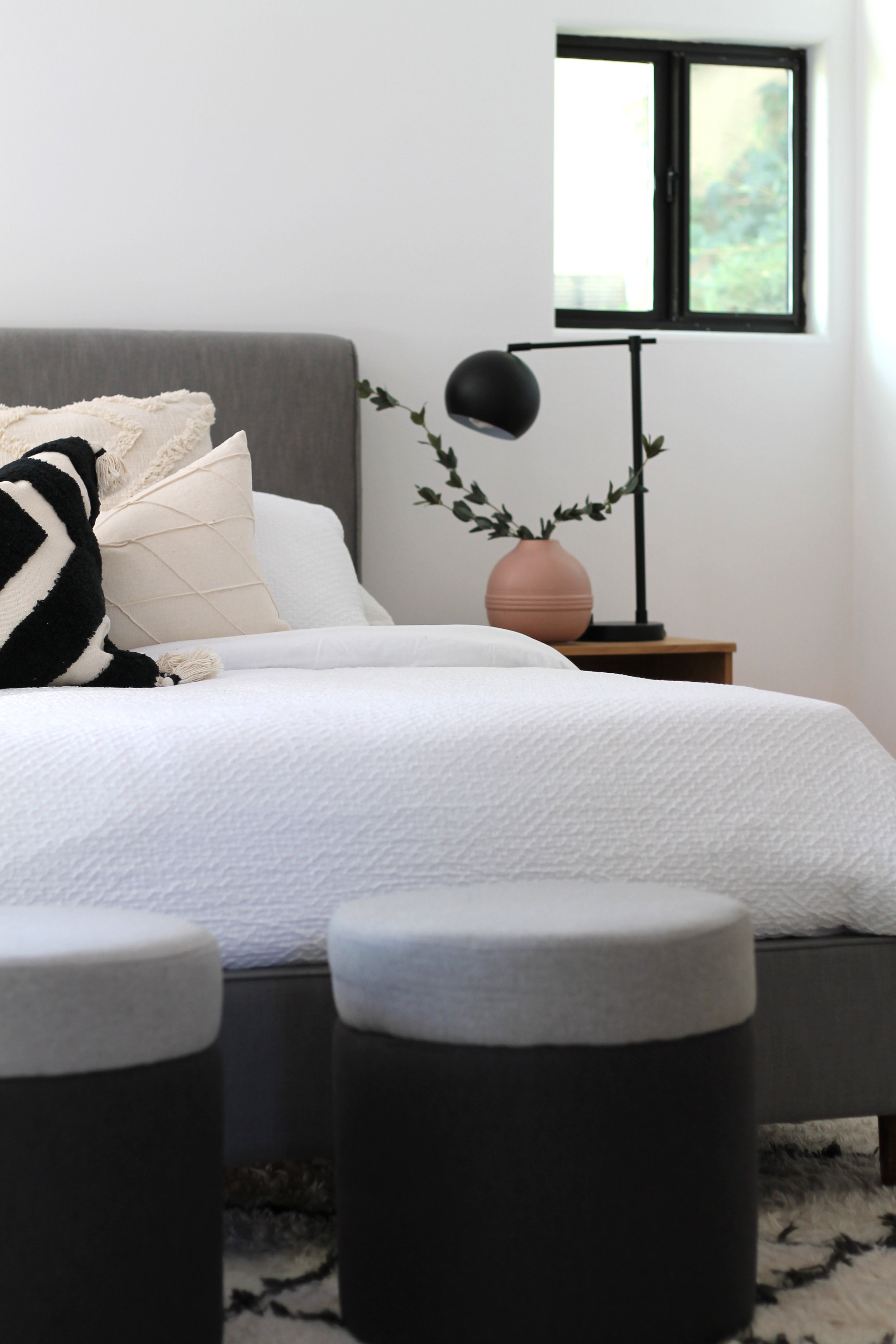Post Modernism: Just A Fleeting Trend?
What typifies Post-Modernism? In the case of this home — built in 1988 during the Post Modern era of the 1980s — it’s simplicity, white walls, curved architectural lines, the stark contrast of B&W and light maple floors. And how does one address this style without shoe-horning it into a narrow category of potential buyers? We chose a neutral palette which would highlight the home’s architecture without screaming 1980s. Decade-spanning and chameleon-like pieces like the classic Panton S chair feel right at home here despite their late ‘50s age. This home, sold empty, would emphasize its age in a negative way. In other words, through staging we can show intent and a contemporary mind-set in the space. Rather than looking like a home from 1988, it looks like a home from today that nods to a Post-Modern aesthetic. That’s the smoke-and-mirrors stuff of staging, and what continues to fascinate us.
The “smokestack” architectural fireplace feature is pure 1980s in shape and style. Geometrics were popular and show up in the form of circular, angular, triangular and ovoid shapes during this era. We responded by bringing in curved metal upholstered chairs, a diamond-pattern Moroccan rug and square-shaped framed art. The cubes on either side of the fireplace gave us ample room to play with textural bowls, neutral books and earthy ceramics to warm up the room.
Color is used judiciously here. A little olive green — when mixed with warm and cool neutrals — becomes neutral itself. And the natural world is always represented in our stagings. Large Monstera leaves, oceanic art, a naturally-shed sheep’s horn and a wooden box all speak of the organic and wild. A dark credenza serves as a grounding element against all-white walls.
The simple matte black and glass pendant hanging above the dining table is a pure example of 1980s Post-Modernism. But despite its age, it could easily be sold today as new in an upscale lighting shop. That’s the beauty of vintage pieces. They will always return to fashion if one waits long enough. Which leaves us wondering, is the 1990s close behind? And what of value can be dredged up from the ‘90s that will be the next “it” trend of the 2020s? We’ll have to ponder that one a little. Obviously, some decades are better than others. Look how long the 1950s-’60s craze has lasted. And with all the current interest in the 1970s-’80s, we could see these influences stick around for decades more. Looks like its time to invest in some bulbous rounded furniture!
Back to nature for a minute, let’s pause to consider the root table, formerly relegated to a roadside attraction in a mountain town. Many a time we’ve passed artisans selling root furniture by the side of the road. Wishing now we had bought all of it. Just all of it. This show-stopper crowns the room with eccentricity and hits all the right notes. Post-Modern style can be a bit dry and tends toward masculinity. But the introduction of a flowing organic shape causes a stir in the environment and opens it up to unknown and feminine energy.
We fully adhere to the belief that if one appreciates a certain form of art — and actually needs large scale abstracts for their staging business — that one should DIY that shit. So yes, if you like Franz Kline, with a modicum of talent you can reproduce it.
We don’t know exactly what it is about blush pink, but when mixed with B&W, it’s kind of the perfect ‘80s color. We have been finding some great home decor from Joann Fabrics (yes, that Joann) like this vase in Dolomite Pink. Round felt ottomans at the foot of the bed are from Wal-Mart’s MoDRN line. Domino magazine wrote about this product line in glowing terms, and we purchased many of these items in 2019 (before the supply chain breakdown). Now we see they’re in short supply — but still well-priced and worth the style dollars.
Another favorite 1980s-influenced bedroom — the primary bedroom in the home — features our B&W color scheme but with the addition of terra cotta (also an ‘80s favorite). We had a couple of lamps we liked but which had a dated finish, so we DIYed ourselves into terra cotta ceramic lamps just by custom-mixing paint until we reached the desired hue. Topped off with black lampshades, these of-the-moment lamps are ready for their closeup. CB2’s now-discontinued white lacquer cubes form a foot-of-bed ottoman and a shaggy cream-colored Moroccan rug adds texture underfoot. A common feature in Post-Modern upholstery is channel-tufting. This bed fulfills all our ‘80s dreams with its Art-Deco Revival influences. We’ve been doing all-white bedding lately, with textural elements like the pom-poms here. Stark black Euro sham pillows stand out against the clean white background. A B&W pattern comforter folds near the foot of the bed for heft and height, creating a confection of a bed just ripe for napping.








